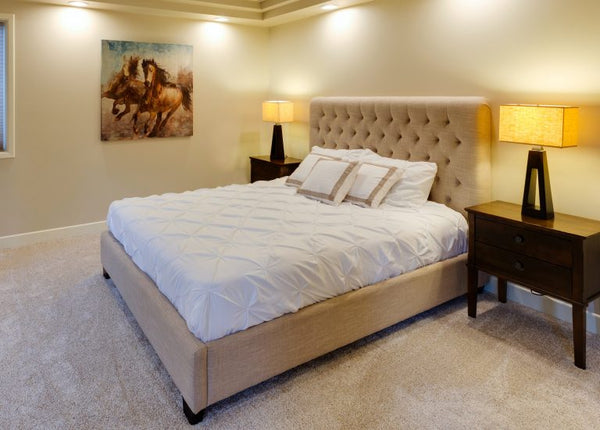When it comes to enjoying a pleasant night’s sleep, quality bed linens are crucial. When we talk about comfort, the bed sheet is the prominent bed linen among the rest of the bedding range.
Because sheets lie directly on the skin, you want them to be composed of a soft material that is also breathable and won’t irritate the skin. Bed sheets should be composed of a sturdy, long-lasting fabric to resist repeated washings and the wear and tear that goes along with them.
Cotton and microfibre are two common materials for bed linens. Microfiber is a synthetic textile made of ingredients like polyester or nylon, whereas cotton is a natural fiber obtained from cotton plants.
What is a Cotton Sheet?
Cotton is a 100% natural substance that is breathable, absorbent, and keeps sleepers cool all night, especially on white bed sheets. For people with skin sensitivities, cotton is commonly advised because it is hypoallergenic.
Cotton sheets are also easily accessible in a variety of thread counts, weave patterns, and price ranges. Following, we discuss how cotton compares in terms of breathability, feel toughness, and variety.

-
Breathability
No matter the temperature or body heat, cotton sheets are 100% breathable, making it simple for air to move through.
In addition to being incredibly absorbent and having antibacterial qualities, the material is gentle on the skin. People with hot climates find it quite simple because cotton sheets dry quickly.
-
Durability
It’s well known that cotton sheets retain their suppleness while being durable. They are durable and do not sag over time after repeated washing. If you buy cotton bed sheets, it will be a wise investment because they can easily last six years.
-
The Thread Count
The thread count is the number of threads used to weave a sheet per square inch. A thread count of 300 to 400 is typical for cotton sheets. In general, smoother, softer, and stronger sheets have a higher thread count.
-
Cotton Long-Staple
In the market, there are numerous varieties of cotton. Pima cotton, Egyptian cotton, Turkish cotton, and other types of cotton may be found when shopping for cotton bed linens.
Extra-long and regarded as of the highest quality are Pima and Egyptian cotton. This sheet is more durable than others because it has an “extra-long-staple” on the label.
-
Maintenance
A cotton sheet is simple to keep because it can be washed in the washing machine without any particular care. As you wash the cotton sheets, they gradually get softer and smoother. Contrary to other materials, cotton doesn’t require particular care and isn’t fragile.
-
Weave
Interlocking weaves are frequently used in the production of cotton sheets. These enable the sheets to be extremely resilient and endure the test of time. Sateen, flannel, and percale are the most typical cotton weaves for bed linens.
What is a Microfiber Sheet?
Microfiber sheets are those created from polyester, nylon, or other materials. It is a popular synthetic materials substitute for cotton. The lightweight fabric is made from fibers that are much thinner than silk and firmly woven together.
Since they are made of synthetic material, they are more resistant to wrinkling and shrinking after washing. The fabric feels nice on the skin and is fairly breathable.
To make the sheets firmer and softer, thicker strands are woven into the fabric. Additionally, these sheets could contain recycled materials or finely powdered wood pulp.

- Breathability
Is microfibre permeable to air? Yes. Despite not being made of natural fibers, microfiber sheets are incredibly breathable.
Microfiber keeps the bedding dry by repelling water. It is utilized in athletic clothes due to its capacity to wick away sweat.
The fabric is designed to maintain a consistent body temperature, keep you dry and comfortable, and ward off heat and moisture. These sheets prevent allergies as well as heat and sweat. The majority of the time, these sheets do not irritate skin while fighting off dust.
-
Durability
As durable as cotton sheets, microfiber sheets are also breathable. But after several items of washing, these sheets become softer. It’s possible that the bed sheets won’t last very long if they’re not of great quality. So be sure to check the GSM or get a high-quality microfiber sheet when you’re shopping.
-
Maintenance
Because they don’t require fabric softeners or other extra care, microfiber sheets are minimal maintenance. Furthermore, these sheets are largely wrinkle-free and do not shrink after washing.
Cotton Sheets
| PROS | CONS |
| It is made of natural fiber | It can get wrinkles easily |
| Available at reasonable prices | It can shrink after washing |
| It has anti-allergic properties and is breathable with moisture-wicking properties. | More expensive than microfiber sheets |
| Doesn’t require high maintenance |
Microfiber Sheets
| PROS | CONS |
| Wrinkle-free and very soft on the skin | More likely to generate static |
| It has anti-allergic properties, hence softer on the skin | High absorbency however more prone to stains |
| It is soft in nature and lightweight | Made of synthetic materials that’s why might irritate the sensitive sleepers |
Which is preferable: either cotton or microfiber?
The decision of choosing microfiber vs cotton sheets or which bedding is superior depends greatly on personal preference. Cotton sheets support the fabric’s renowned breathability, suppleness, and sigh-inducing softness.
Cotton sheets are an excellent investment for any sleeper because of their eco-friendliness and the fact that they are hypoallergenic and temperature-regulating.
Despite being a synthetic material, microfiber does not lack in quality when compared to other natural fabrics.
Microfiber sheets are a great option for anyone looking for high-quality, low-maintenance bedding due to their moisture-wicking and stain-resistant qualities as well as their silky-satin feel.








